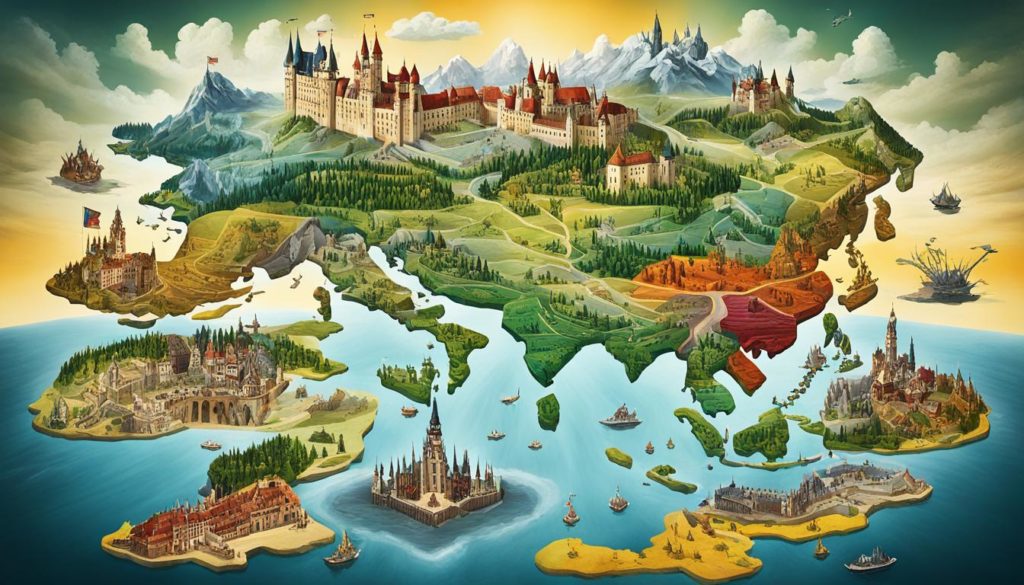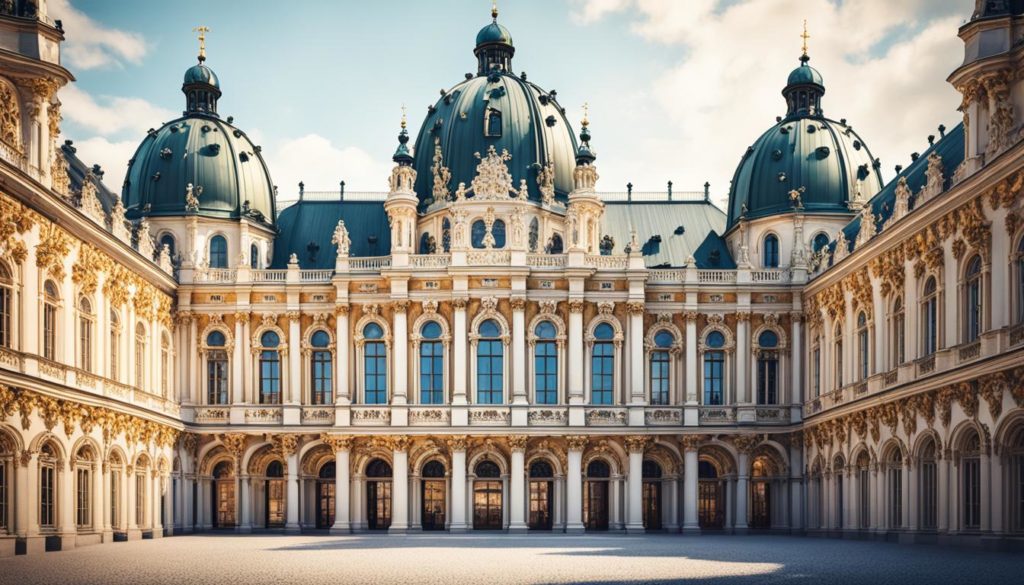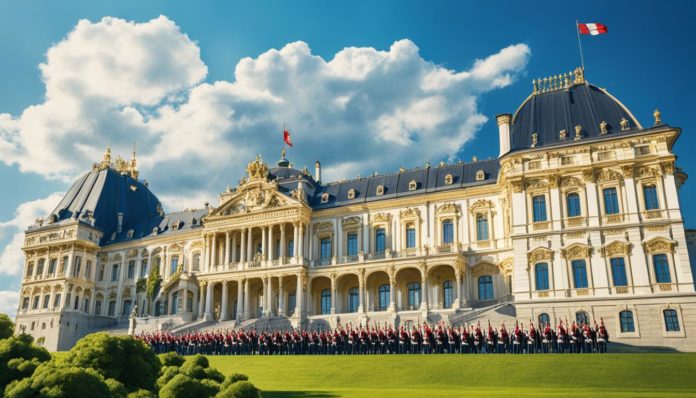The Habsburg monarchy was a powerful group of territories ruled by the House of Habsburg. It started when Rudolf I became King of Germany in 1273. Over time, the Habsburgs gained control of the Duchy of Austria in 1282 and later the Holy Roman Empire from 1438 to 1806.
At its peak, under Charles V in the 16th century, the Habsburg Monarchy was incredibly influential. It was one of the most powerful families in European history. They greatly shaped the politics and culture of Central Europe for many years.
Key Takeaways
- The Habsburg Monarchy was a vast and influential empire that ruled over Central Europe for centuries.
- The dynasty traced its origins back to the election of Rudolf I as King of Germany in 1273.
- The Habsburgs acquired the Duchy of Austria in 1282 and went on to rule the Holy Roman Empire from 1438 to 1806.
- At its peak under Charles V in the 16th century, the Habsburg Monarchy was one of the most powerful dynasties in European history.
- The Habsburg Monarchy’s legacy shaped the political and cultural landscape of Central Europe for generations.
Origins and Expansion of the Habsburg Dynasty
The Habsburg dynasty started with Radbot of Klettgau, a nobleman from the Franks. He built the Habsburg Castle in Switzerland in the late 10th century. Over time, the Habsburgs grew to be one of Europe’s most powerful royal families.
The Acquisition of Austria and the Holy Roman Empire
In 1279, the Habsburgs took control of the Duchy of Austria, part of the Kingdom of Germany in the Holy Roman Empire. King Rudolf I gave the Duchy to his sons in 1282. This move created the “Austrian hereditary lands” and the House of Austria. The Habsburgs kept gaining power and became rulers of the Holy Roman Empire in the 15th century.
Maximilian I and the Burgundian Inheritance
Maximilian I helped the Habsburgs become even more powerful by marrying into the Burgundian Netherlands. His grandson, Charles V, then got the vast Habsburg lands, including Spain and its colonies. This made the Habsburgs the biggest empire in Europe at the time.

“The Habsburgs grew in power and prominence due to the dynastic policies of Maximilian I, who acquired the Burgundian Netherlands through marriage, and his grandson Charles V, who inherited the vast Habsburg domains, including Spain and its colonies, making the Habsburg possessions the largest empire in Europe at the time.”
The Habsburgs’ growth in the late 15th and early 16th centuries set the stage for their lasting impact on European history.
The Division and Reunification of the Habsburg Realms
The House of Habsburg was a powerful royal family in Europe. In the 16th century, they faced a big division that changed European history. Charles V, the Holy Roman Emperor, gave up his power in 1556. He gave the Austrian lands and the crown to his brother Ferdinand I. The Spanish Empire and its colonies went to his son Philip II. This split the Spanish and Austrian lines of the Habsburgs.
The Austrian Habsburgs grew their power, adding the Kingdoms of Bohemia and Hungary in the 16th century. They became even more powerful in Central Europe. The Spanish and Austrian lines stayed separate for over a hundred years.
The Reunification under the Austrian Habsburgs
From 1564 to 1665, the Habsburg family was divided. But then, the Austrian Habsburgs came together again under one rule. This lasted until the dynasty ended in the male line in 1740. The dynasty then kept going through the House of Habsburg-Lorraine. They kept control over the Holy Roman Empire, Hungary, and Bohemia.
| Key Events | Timeframe |
|---|---|
| Charles V divides the House of Habsburg | 1556 |
| Austrian Habsburgs acquire Bohemia and Hungary | 16th century |
| Reunification of Austrian Habsburgs | 1564-1665 |
| Habsburg dynasty becomes extinct in male line | 1740 |
| House of Habsburg-Lorraine continues the dynasty | 1740 onwards |
The reunification of the Habsburg realms under the Austrian branch changed Central Europe for centuries. It left a legacy that still interests historians and the public today.

History of the Habsburg Monarchy in Central Europe
The Habsburg Monarchy’s history in Central Europe was full of big events and changes. A key moment was the Austro-Hungarian Compromise of 1867. This deal created the Dual Monarchy of Austria-Hungary. It gave more power to the Kingdom of Hungary but kept the Habsburgs in charge of both the Austrian Empire and the Kingdom of Hungary.
The Austro-Hungarian Compromise of 1867
The Austro-Hungarian Compromise of 1867 was a big turning point. It made Austria-Hungary a Dual Monarchy, giving Hungary more freedom but keeping the Habsburgs in power. This was done to deal with growing national feelings in the empire, helping the Habsburgs keep their rule.
The Reign of Franz Joseph and the Decline of the Monarchy
Emperor Franz Joseph ruled from 1848 to 1916. His time was marked by both progress and decline. The empire changed a lot but faced big challenges in the 20th century, like rising nationalism and other European powers getting stronger.
The monarchy slowly fell apart over time. It faced political and economic problems and lost its old power in Central Europe. Franz Joseph and others tried to keep the empire strong, but it couldn’t keep up with the changing world.

“The stakes of the election in 1911 may not have been exceptional, but the high level of voter participation indicates the perceived importance of the election.”
The Legacy of the Habsburg Dynasty
The Habsburg dynasty made a lasting impact on Central Europe and beyond. They were known for their cultural achievements and architectural grandeur. For centuries, they had a big influence on European history and politics.
Cultural and Architectural Achievements
The Habsburgs loved the arts and built amazing palaces. These palaces, like Schönbrunn and Hofburg in Vienna, still amaze people today. They show the dynasty’s power and taste in architecture.
They also helped shape Central Europe’s culture. By supporting the arts, literature, and music, they created a place where great talents thrived. Their influence is still seen in the opera houses, music, and literature of the region.
The Influence on European History and Politics
The Habsburgs ruled Europe for a long time. The Holy Roman Emperors from this family were key in shaping politics. They grew their empire through smart marriages and expansion, becoming a top royal house in Europe.
Their rule led to the creation of lasting political and cultural institutions. The complex government and diverse people of the Habsburg Monarchy set the stage for modern European governance.
After the Habsburg Monarchy ended in 1918, their impact is still seen in Central Europe’s politics, culture, and architecture. The Habsburgs’ lasting legacy shows their big achievements and the mark they left on European history.

Conclusion
The Habsburg monarchy’s impact on Central Europe is huge. It changed the region’s politics, culture, and architecture for centuries. Starting with the 13th century, the House of Habsburg ruled and shaped European history.
Even after World War I ended the monarchy, the Habsburgs’ influence lives on today. Their buildings and cultural achievements still inspire us. With Austria’s population at 9,295,000 in 2024, their legacy is a key part of the nation’s identity.
Today, Austria faces new challenges, like the end of a climate group aiming to protect a Klimt painting. Yet, the Habsburgs’ legacy reminds us of Austria’s strength and ability to adapt. As Austria looks to the future, the Habsburgs’ impact will keep shaping its culture, politics, and economy.
